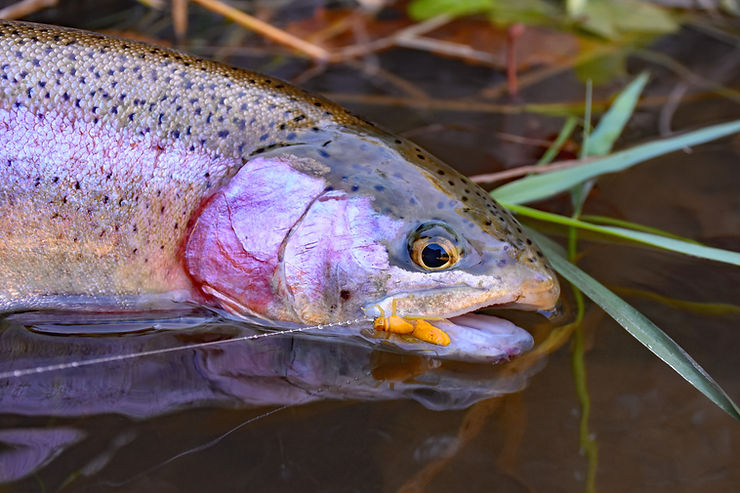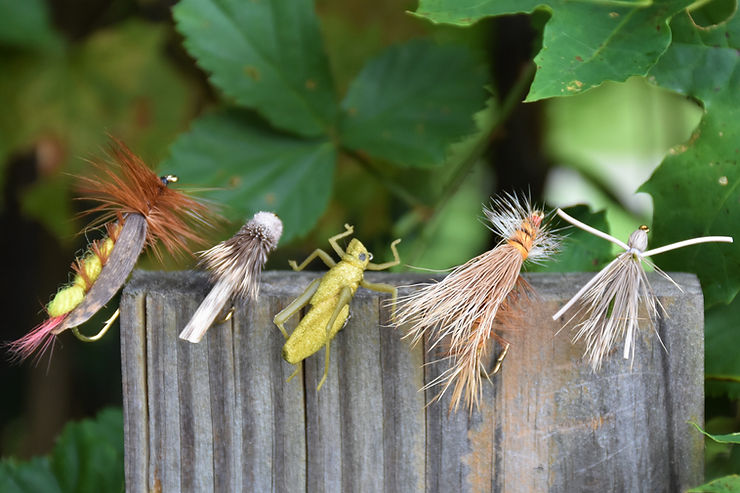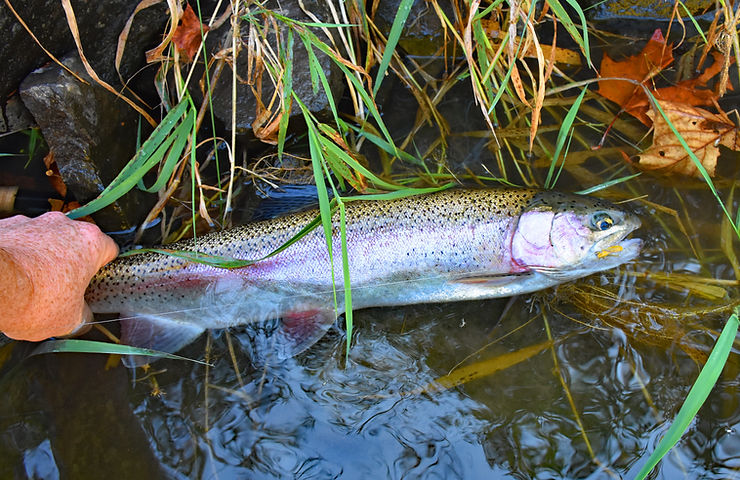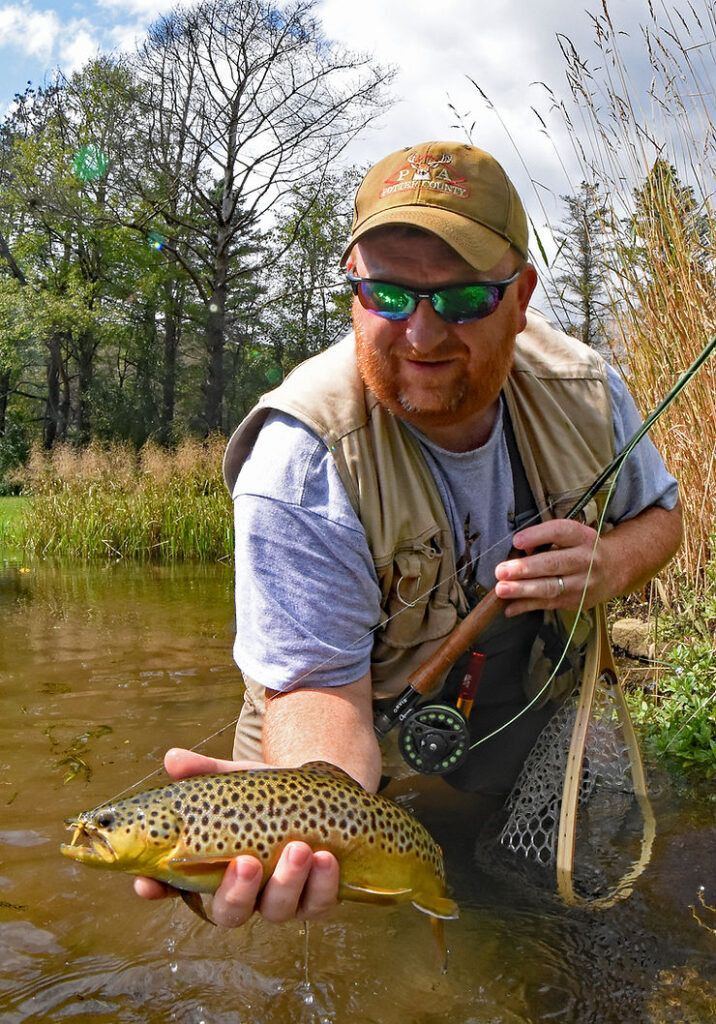Hoppers and Droppers, Oh My!

Hopper fishing defies the most basic rules of fly casting. No need for those elegant, wistful casts, and nobody cares about the perfect, drag-free drift. These are big, gaudy patterns meant for chucking and ducking rather than soft presentations that flutter to the surface, but they catch trout, and sometimes lots of them.
Grasshoppers, of course, are terrestrial insects that can fall, leap, get washed by rain or blown by wind into the water. Of all the various terrestrials that can find their way onto a trout’s menu – ants, beetles, and caterpillars to name a few – hoppers are the most exciting because they offer a big meal that often draws the attention of the biggest fish in the stream.
My hopper fishing begins right around now, mid-June, and lasts well into September, and occasionally, weather permitting, the action can continue into early October. A couple years ago (on September 23rd, according to my notes), I was fishing one of the Keystone Select Trout Waters and caught five trout between 12 and 24 inches. All of them were caught in a two-hour window in the middle of the afternoon, when the water was flat calm and the sun baked down. And all of them took a hopper.
The following weekend, I fished that same stretch again and wrangled in a few more big trout. It was no fluke. Hoppers work!
Choosing A Hopper
The first step to catching trout on hoppers is figuring out what kind of hoppers the trout are keying on. Pay close attention as you walk to the stream, especially through tall grass or fields where you’ll find a lot of insects. Depending on the area and time of year, grasshoppers can range in color from green to brown to yellow. They can also come in sizes 4-14, sometimes bigger. Generally, I stick with patterns in the 8-12 range because hoppers tend to be bulky anyway, and it takes a heck of an aggressive Pennsylvania trout to tackle anything in size 4.

Specifically, early in the season I tend to choose smaller patterns. Right now, there are a plethora of immature hopper young bouncing around on streamside vegetation. For some of them, a size 16-18 would be a more accurate representation, but the majority of the time, a size 14 will do. As the season wears on, and those young of the year grow, I switch over to a size 10 or 12, with size 12 being my favorite.
In my experience, color is more important that size. If you can find a few hoppers in the foliage to use as an example, all the better. If I can’t find one, my default color is a brownish-yellow pattern, only because that’s my “confidence” fly that has produced really well for me on almost every stream I’ve fished.
Hopper imitations come in a variety of styles, from the simplistic Letort Hopper to the more complicated Joe’s Hopper to the realistic J:Son Flies Hopper. All of them work. Even the suggestive, attractor-type patterns such as the Madam X and Stimulator will catch fish zeroing in on hoppers.
My basic rule of thumb for hopper selection is the slower the current, the more realistic the pattern I use. In fast or choppy water, trout are less selective and will strike based on the fly’s profile. In slow water, though, trout have the opportunity to study a pattern, and the more realistic that pattern is, the more strikes it will draw.
Fishing Tactics
Unlike those tiny mayflies that flit along the water’s surface, once a hopper finds its way into the water, it’s stuck, and the trout knows it. There’s no hurry to attack. Some of the biggest fish I’ve landed on hoppers produced the most subtle strikes. They simply come up under the fly and suck it in. This is especially true on many of the highly pressured, special regulation sections that stay cool enough to harbor trout all summer long. Educated fish will sometimes reject a hopper pattern simply based on how it feels in their mouth, which is why soft-bodied flies with supple, silicon legs will produce more quality hook ups.
When hoppers are working, there’s no need to hit the water at the crack of dawn. Most grasshoppers don’t move around much until temperatures warm. In fact, my best experiences with grasshoppers has been right through the hottest part of the day, which happens to be when the insects are most active.
Most terrestrials are best fished along the stream edge and hoppers are no different. Seek out stream sections that have lots of overhanging trees or stands of tall grasses bordering them. Sometimes trout keying on terrestrials will hug the banks, but more often they stage in slightly deeper water just off the edge, and when a bug hits the water, they attack.
Don’t worry about making a soft presentation. Real live grasshoppers land on the water with a splat, and so should your fly. The disturbance alone can be enough to trigger a strike, but if nothing else, it lets trout know that food has arrived.
Rather than cast across a stream to fish the far bank, I like to fish the side I’m standing on. Most of the time I don’t even get in the water, just creep along the bank, dropping the hopper along the edge as I work downstream.
I treat hoppers much like traditional dry flies and prefer a drag-free drift. In this way, hoppers are a lot like fishing for bass with poppers. The temptation is to twitch and jerk the fly, but in reality, most strikes occur when the fly is floating perfectly still. If that’s not inducing strikes, then I’ll impart action in hopes of getting a trout’s attention, but even then, I don’t overdo it. With big, bulky patterns, less is more.

Favorite Droppers
Of course, hoppers don’t always have to be fished on the surface. A percentage of terrestrials inevitably drown and end up deeper in the water column. If nothing is rising to your hopper, try bouncing one along the bottom like a nymph. Or use a hopper-dropper combination by tying a length of tippet to the bend of the hook of the hopper pattern and trailing your favorite nymph behind it, effectively doubling your chances of catching trout.
My favorite droppers are usually some sort of small nymph or emerger, size 16 and smaller. Also, don’t get carried away with the length of tippet for the dropper. My ideal tippet length is around 2 feet. Much longer makes it difficult to detect strikes. Hoppers are good floaters, so when using them as an indicator, the strikes will appear more sublte. There’s more likely to be a short pause in the drift rather than the hopper being tugged under.
Don’t worry about getting the dropper on the stream bottom. Rather, focus on that middle water column where trout like to suspend. Hence, emerger patterns make great droppers off the back of your hoppers.
Another reason for the short tippet on the dropper is that, ideally, you want to pound the banks when fishing hoppers. Sometimes even a 2-foot tippet is too long and I’ll keep dragging bottom. In some cases, I’ve had to drop down to as short as 6 inches with my dropper, but I’ve still caught fish.
Tackling Hoppers
Gearing up to fish with hopper patterns requires a slightly heavier fly rod than usual. These are not dainty mayflies, after all, and it takes some backbone to cast them any distance. My favorite hopper rod is a 9-foot, 6-weight rod with weight-forward floating line. I also like 4x-6x tapered leaders at least nine feet long because most streams are still running at late summer levels and very clear this time of year. I then add a two-foot length of 4x-5x tippet to the leader.
Big flies have a lot of wind resistance and can twist during the cast, which weakens knots and causes wear and tear on your line. To combat this, try connecting the tippet to the leader with a small swivel. The best one I’ve found is the Ultimate Fly Swivel made by J:Son Flies.
Big flies, big splashes, big fish. Heavy rods. Swivels. Forget what you know about graceful fly fishing. It’s time to go sling some hoppers.

Sign up for the Dark Skies Fly Fishing e-newsletter
It's free, delivered to your inbox approximately three times each month. Your information is always kept private and used for the sole purpose of keeping you up to date on blog posts and specials in the online store.
Sign Up Now